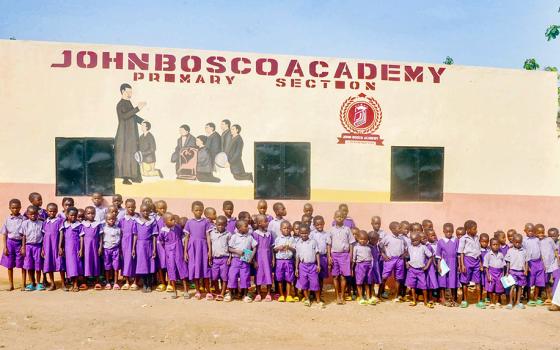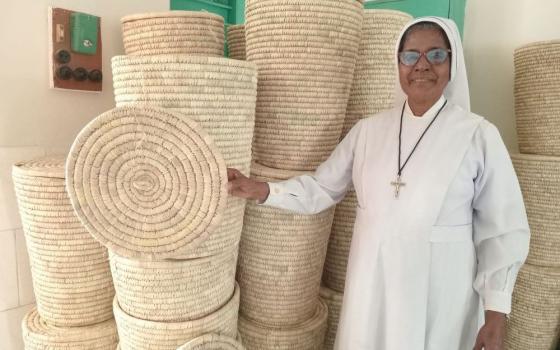
WASHINGTON -- A snapshot of some 220 U.S. Catholic colleges and universities today presents a mixed picture -- much of it positive, but also with some warning signs:
- Current student enrollment of nearly 800,000 is the highest in history and still on the rise, but the number of Catholics among those enrolling is going down.
- As Catholic students in Catholic institutions of higher learning pass from their freshman to sophomore, junior and senior years, their average frequency of Mass attendance goes down -- but the decline in that group is considerably smaller than the decline among young Catholic adults of the same age who attend non-Catholic colleges or who do not go on to college.
- On some issues of church teaching on morality and social justice, Catholic students in Catholic colleges tend away from agreement with Catholic belief as they grow older, but on others they tend to grow closer -- and, as with Mass attendance, on almost all such issues college students in church-run institutions tend to be closer to the church as they grow older than do their counterparts studying in non-Catholic institutions.
- Even as their student population becomes increasingly non-Catholic, more and more Catholic colleges and universities have made conscious institutional efforts to promote their Catholic mission and identity by establishing a mission leader.
- Only 39 percent of Catholic college graduates attend Mass at least weekly -- but that figure compares favorably to the national Catholic average of 30 percent, and even more favorably to the national average of 26 percent among U.S. Catholics who attended a non-Catholic college or university.
- There is a concern among some religious orders -- orders of men or women religious are the founders of most U.S. Catholic colleges and universities -- about how to carry on the mission and charism of the institutions they have founded when they no longer have the personnel within the order to govern the institution.
These were a few of the things reported about the current state of Catholic higher education at the recent annual meeting of the Association of Catholic Colleges and Universities in Washington.
Early in the meeting, researchers from Jesuit-run Boston College reported on their national study that found the number of mission leaders appointed in Catholic colleges and universities rising from just half a dozen in 1990 to nearly 100 today. A mission leader, usually reporting directly to the president of the institution, is responsible for assuring that the institution’s Catholic identity and mission -- and the charism of its founding religious order, if relevant -- are preserved and enhanced through its academic, pastoral and other programs.
Also early in the meeting, researchers from the Center for Applied Research in the Apostolate (CARA), based at Georgetown University in Washington, presented a report that said, in essence, that Catholic students who attend Catholic colleges or universities are far more likely than their peers in non-Catholic educational settings to come out as active, churchgoing Catholics, more in agreement with church teachings and more involved in prayer life, reading scripture and attending religious services, than their counterparts who attended non-Catholic colleges or universities or did not go on to higher education.
 Those findings challenged a recent report by the Cardinal Newman Society, an organization that specializes in denouncing Catholic colleges and universities that do not live up to its definition of orthodoxy. The society used essentially the same data as CARA relied on to argue that Catholic students at Catholic institutions came out less Catholic than they were before their university experience, so Catholic colleges and universities were failing in passing on the faith.
Those findings challenged a recent report by the Cardinal Newman Society, an organization that specializes in denouncing Catholic colleges and universities that do not live up to its definition of orthodoxy. The society used essentially the same data as CARA relied on to argue that Catholic students at Catholic institutions came out less Catholic than they were before their university experience, so Catholic colleges and universities were failing in passing on the faith.
CARA analyzed the data in comparison with Catholic students who attended non-Catholic institutions and found that those in Catholic institutions were far more in sync with the church after several years of Catholic higher education than their peers who did not attend a Catholic college or university. In short, Catholic higher education left its recipients more Catholic, not less Catholic, when compared with others of their same age and educational level.
Richard A. Yanikoski, who this August is retiring after five years as president of the Association of Catholic Colleges and Universities, highlighted the Boston College and CARA findings as well as other studies in his closing presidential address, in which he described what he called the “untold story” regarding Catholic higher education in the United States.
Yanikoski noted that in 1900, Catholic colleges and universities had a total enrollment of 4,220 students. That grew to 290,000 students in 1950 and nearly 800,000 in 2010, he said.
“We intentionally teach significant numbers of first-generation learners, at-risk students and students from lower-middle-income families while also serving students of extraordinary ability with the means to go to any college of their choice,” he said. “In short, we teach, serve and respect all who come to us, asking only that they respect our Catholic identity, strive to succeed and pay their bills.”
Yanikoski also noted, however, that both the number and the proportion of Catholic students in U.S. Catholic colleges and universities have declined in recent decades.
Among full-time freshmen enrolling in four-year Catholic institutions -- the only figure available as a multiyear statistic -- those “who self-report being Catholic declined from 82 percent in 1979 to 73.2 percent in 1989 to 66.2 percent in 1999 to 55.4 percent in 2009,” he said. Coupled with figures on similar but less severe declines in Catholic enrollment in Catholic elementary and secondary schools, Yanikoski called the statistics “a sobering trend” that “warrants further study.”
He said the changing nature of the student body has left Catholic higher education leaders divided. While they want to promote their Catholic identity in order to attract more Catholic students, all are committed to serving the actual student body as best they can, he said.
“Explorations regarding how the Catholic faith and intellectual tradition can appropriately enrich learning in major fields of study and in professional programs have become the focus of an ever-growing array of campus-based, regional and national workshops,” Yanikoski said.
He also said numerous Catholic colleges and universities have recently initiated centers or institutes devoted to studies of Catholic thought or inaugurated projects devoted to publication of Catholic scholarship.
[Jerry Filteau is NCR Washington correspondent.]







